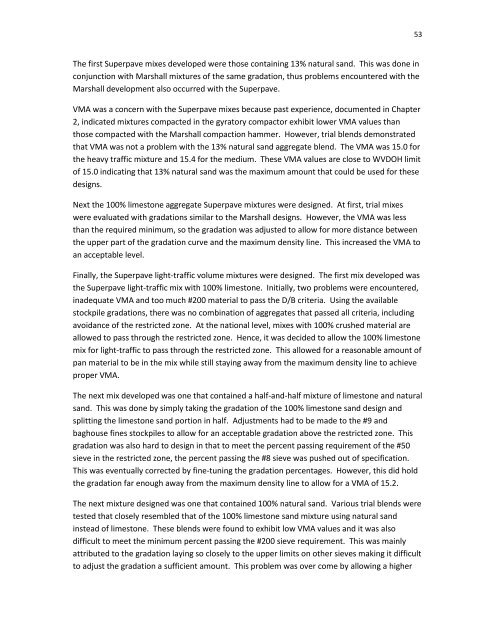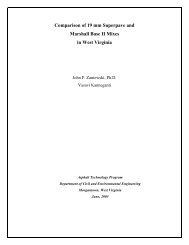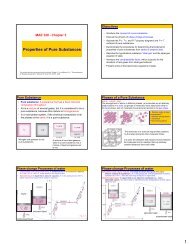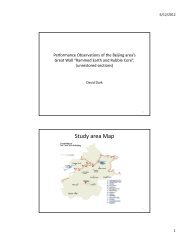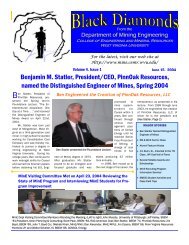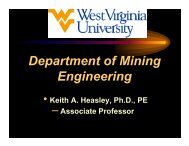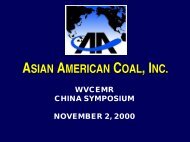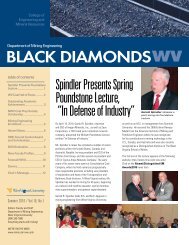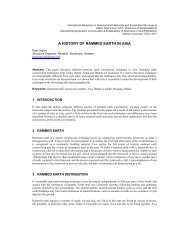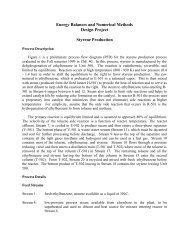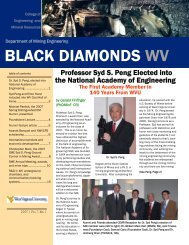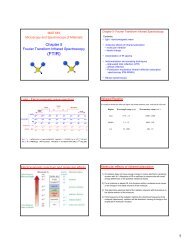Comparison of 9.5 mm SuperPave and Marshall Wearing I Mixes in ...
Comparison of 9.5 mm SuperPave and Marshall Wearing I Mixes in ...
Comparison of 9.5 mm SuperPave and Marshall Wearing I Mixes in ...
You also want an ePaper? Increase the reach of your titles
YUMPU automatically turns print PDFs into web optimized ePapers that Google loves.
53The first Superpave mixes developed were those conta<strong>in</strong><strong>in</strong>g 13% natural s<strong>and</strong>. This was done <strong>in</strong>conjunction with <strong>Marshall</strong> mixtures <strong>of</strong> the same gradation, thus problems encountered with the<strong>Marshall</strong> development also occurred with the Superpave.VMA was a concern with the Superpave mixes because past experience, documented <strong>in</strong> Chapter2, <strong>in</strong>dicated mixtures compacted <strong>in</strong> the gyratory compactor exhibit lower VMA values thanthose compacted with the <strong>Marshall</strong> compaction ha<strong>mm</strong>er. However, trial blends demonstratedthat VMA was not a problem with the 13% natural s<strong>and</strong> aggregate blend. The VMA was 15.0 forthe heavy traffic mixture <strong>and</strong> 15.4 for the medium. These VMA values are close to WVDOH limit<strong>of</strong> 15.0 <strong>in</strong>dicat<strong>in</strong>g that 13% natural s<strong>and</strong> was the maximum amount that could be used for thesedesigns.Next the 100% limestone aggregate Superpave mixtures were designed. At first, trial mixeswere evaluated with gradations similar to the <strong>Marshall</strong> designs. However, the VMA was lessthan the required m<strong>in</strong>imum, so the gradation was adjusted to allow for more distance betweenthe upper part <strong>of</strong> the gradation curve <strong>and</strong> the maximum density l<strong>in</strong>e. This <strong>in</strong>creased the VMA toan acceptable level.F<strong>in</strong>ally, the Superpave light-traffic volume mixtures were designed. The first mix developed wasthe Superpave light-traffic mix with 100% limestone. Initially, two problems were encountered,<strong>in</strong>adequate VMA <strong>and</strong> too much #200 material to pass the D/B criteria. Us<strong>in</strong>g the availablestockpile gradations, there was no comb<strong>in</strong>ation <strong>of</strong> aggregates that passed all criteria, <strong>in</strong>clud<strong>in</strong>gavoidance <strong>of</strong> the restricted zone. At the national level, mixes with 100% crushed material areallowed to pass through the restricted zone. Hence, it was decided to allow the 100% limestonemix for light-traffic to pass through the restricted zone. This allowed for a reasonable amount <strong>of</strong>pan material to be <strong>in</strong> the mix while still stay<strong>in</strong>g away from the maximum density l<strong>in</strong>e to achieveproper VMA.The next mix developed was one that conta<strong>in</strong>ed a half-<strong>and</strong>-half mixture <strong>of</strong> limestone <strong>and</strong> naturals<strong>and</strong>. This was done by simply tak<strong>in</strong>g the gradation <strong>of</strong> the 100% limestone s<strong>and</strong> design <strong>and</strong>splitt<strong>in</strong>g the limestone s<strong>and</strong> portion <strong>in</strong> half. Adjustments had to be made to the #9 <strong>and</strong>baghouse f<strong>in</strong>es stockpiles to allow for an acceptable gradation above the restricted zone. Thisgradation was also hard to design <strong>in</strong> that to meet the percent pass<strong>in</strong>g requirement <strong>of</strong> the #50sieve <strong>in</strong> the restricted zone, the percent pass<strong>in</strong>g the #8 sieve was pushed out <strong>of</strong> specification.This was eventually corrected by f<strong>in</strong>e-tun<strong>in</strong>g the gradation percentages. However, this did holdthe gradation far enough away from the maximum density l<strong>in</strong>e to allow for a VMA <strong>of</strong> 15.2.The next mixture designed was one that conta<strong>in</strong>ed 100% natural s<strong>and</strong>. Various trial blends weretested that closely resembled that <strong>of</strong> the 100% limestone s<strong>and</strong> mixture us<strong>in</strong>g natural s<strong>and</strong><strong>in</strong>stead <strong>of</strong> limestone. These blends were found to exhibit low VMA values <strong>and</strong> it was alsodifficult to meet the m<strong>in</strong>imum percent pass<strong>in</strong>g the #200 sieve requirement. This was ma<strong>in</strong>lyattributed to the gradation lay<strong>in</strong>g so closely to the upper limits on other sieves mak<strong>in</strong>g it difficultto adjust the gradation a sufficient amount. This problem was over come by allow<strong>in</strong>g a higher


